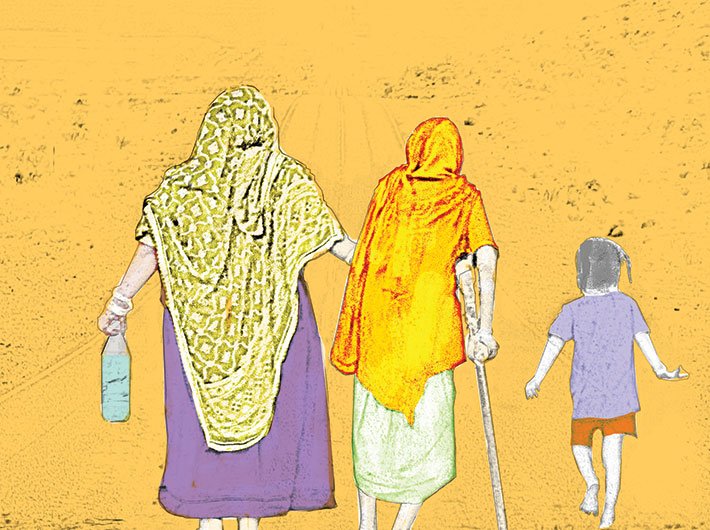Subsidy-driven Swachh Bharat is a failed, old idea. What is needed to stop open defecation is a community-driven approach that has worked wonders in Bangladesh
On the occasion of Gandhi Jayanti last year, the then newly elected Modi government launched the Swachh Bharat Abhiyan with zeal. A host of ministers, including the PM himself, were seen on the streets with brooms in their hands, promoting and propagating the mission. The programme set up an ambitious target of constructing 12 crore toilets in five years, that is, before October 2019. The government aims to achieve total sanitation.
But does India really need a tsunami of toilets?
The question forces itself to come to the forefront as subsidy-driven sanitation programmes in India have been pumping crores of rupees for the past three decades, without any success in bringing down open defecation.
The goal of all previous governments has been to achieve total sanitation or a complete stop to open defecation. In 1999, the NDA government called its programme Total Sanitation Campaign which was later renamed as Nirmal Bharat Abhiyan by the UPA government in 2012. And now the new government calls it Swachh Bharat Abhiyan (SBA). Moving towards its target, SBA has already provided 95 lakh toilets. But do they work? More importantly, do all of them even exist? These are the questions no one is asking, least of all the government.
The 12 crore target is based on the number of households which are still practising open defecation. If, on average, a household has five members, then the population that would be covered under SBA in five years would be 60 crore.
Despite change in governments over the past few decades, the strategy for achieving total sanitation has remained the same – to provide subsidy for building toilets free of cost. “The philosophy seems to be that people don’t have toilets because they can’t afford them. Or because people are idiots and don’t know how to get toilets,” says Kamal Kar, who pioneered a no-subsidy approach called the Community-Led Total Sanitation (CLTS). Kar was honoured with the 2015 Sarphati Sanitation Life Time Achievement Award in November this year at Amsterdam.
Interview: Kamal Kar, Chairman, CLTS Foundation
CLTS is a demand-driven sanitation approach where people change behaviour through peer pressure and awareness. People are taught to find out how exactly their neighbours’ faeces is entering their food. Once they know that, they would stop open defecation, subsidy or no subsidy, says Kar.
CLTS has been embraced by about 60 countries all over the world. They include neighbouring Bangladesh, Pakistan and Nepal. According to Kar, Bangladesh started off worse than India a decade ago but is now all set to declare itself open defecation-free in 2016. Pakistan is also moving in the same direction though it calls CLTS as Pakistan Approach to Total Sanitation (PATS). So is Nepal. But India continues to follow the subsidy approach which is a top-down outlook.
The government’s role has principally been that of a supplier. Kar says this approach has led to supply of a large number of toilets which have crossed the number of households requiring toilets. “If one counts the toilets supplied under all the central and state programmes in the past 30 years, it is a tsunami of toilets that India faces with the SBA too willing to achieve its target.”
The present target for total sanitation under SBA is to construct 65,000 toilets every day, says Kar. To ensure this, the subsidy has been increased three to four times. Earlier it was '7,500 per household, whereas now it is '12,000 per household. The outcome of all these supply-driven programmes has also been much the same. Open defecation continues.
Kar cites the census findings of 2011. It indicates that 70 million toilets are missing. Where did they disappear? he asks. It points to something. But no one is willing to look into it or learn a lesson, says Kar. Besides, 600 million people still defecate in the open as per the census, he adds. So what happened to the toilets? Shouldn’t someone look at the fate of toilets that are already there through government subsidies? Kar asks.
Where India stands
| Year |
Population (in crore) |
Open defecation (unimproved) in urban areas (in population %) |
Open defecation (unimproved) in rural areas (in population %) |
Open defecation (unimproved) all over (in population %) |
| 1990 |
86.88 |
29 |
91 |
75 |
| 2015 |
128.23 |
10 |
61 |
44 |
In October, a workshop called Journey to Zero was held in Dhaka, in preparation for the sixth conference of South Asian Conference on Sanitation (SACOSAN). Kar, who was invited at the workshop, said that India spends one of the highest amounts on sanitation each year. But it has the largest number of people who practise open defecation.
Bangladesh adopted CLTS in 1999. Kar, who had then been working on participatory approaches to social problems, conceived this approach which was rooted in creating awareness about faecal contamination of food and motivating communities to analyse and map contamination of their food through open defecation. Bangladesh, under the guidance of Kar, decided to go for this approach. At that time only 33 percent people in Bangladesh had access to toilets.
Dhaka which hosted the first SACOSAN conference in 2003 will host the sixth summit next year in January. And it is expected that Dhaka will declare itself to be open defecation-free there.
Kar cites the example of Bangladesh to show that it is not the want of wealth that hinders total sanitation. When Bangladesh started its journey to total sanitation in 1999, it was the third poorest nation, as per UNDP. But according to the joint monitoring program progress report on sanitation and drinking water (2015) by WHO and UNICEF, Bangladesh has already achieved 99 percent of the total sanitation target as well as part of goal seven of millennium development goals, which is total sanitation.
India has taken the political decision to stick to wrong decisions despite knowing that they never worked, says Kar. The only state which tried to shift to CLTS was Himachal Pradesh in 2006, and it was a success. But the state government later went back to the subsidy driven approach. Today no state has the courage to defy the centre as they fear that subsidy would be denied to them and they would lose out financially. Besides, every government loves subsidies. It is a known fact and Kar blames this primarily for government’s bias towards subsidy-based approach and its failure to wipe out open defecation.
“CLTS is no rocket science. The whole world has understood it. If you don’t change behaviour, then you won’t use a toilet even if you have one,” says Kar. The numbers say it all. The money allocated for sanitation year after year has said it all. Unfortunately, policy makers who need to realise the futility of their efforts and expenditure refuse to wake up.
Menon is a freelance journalist

